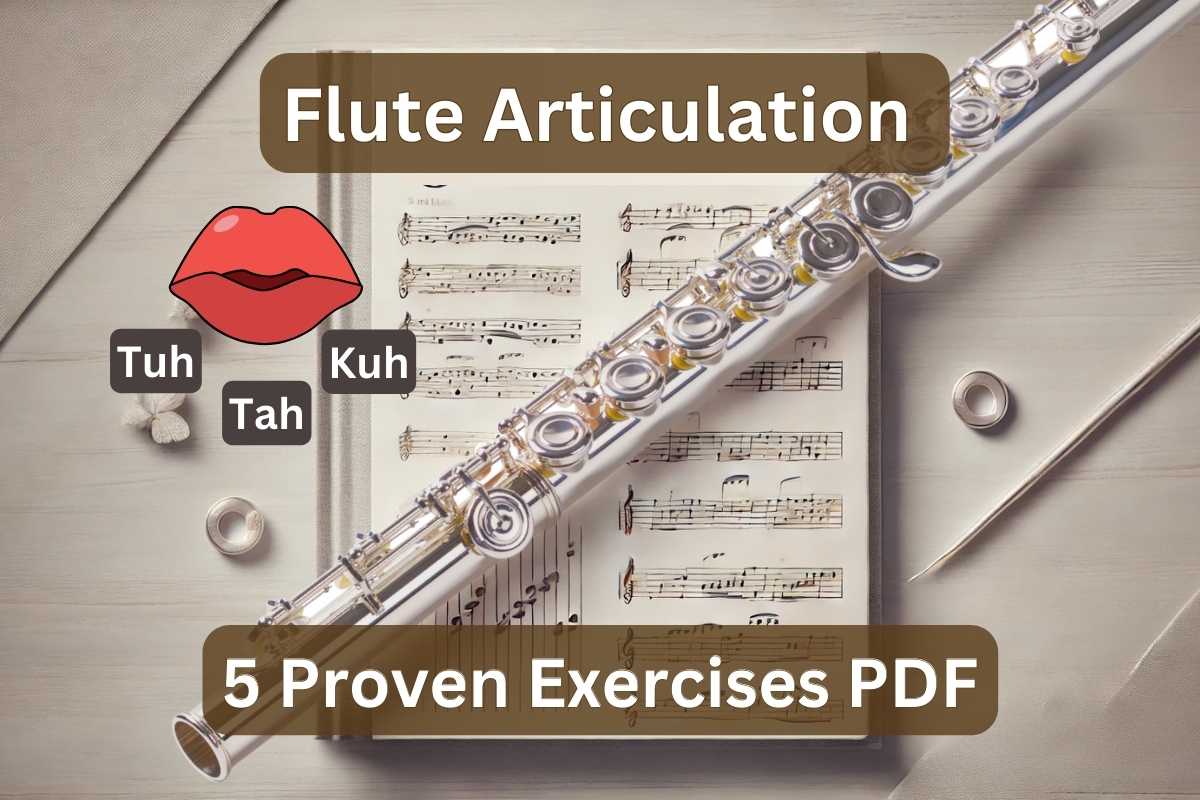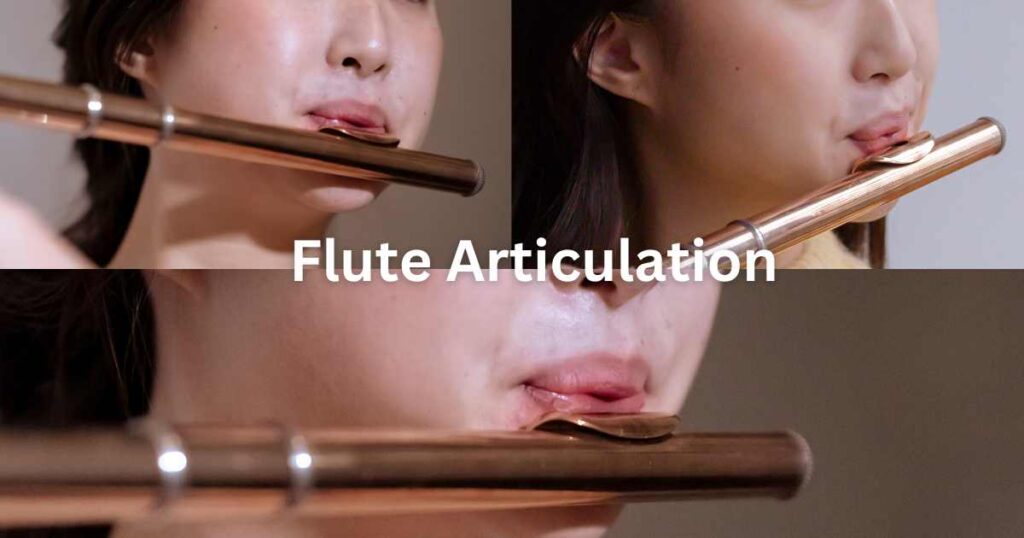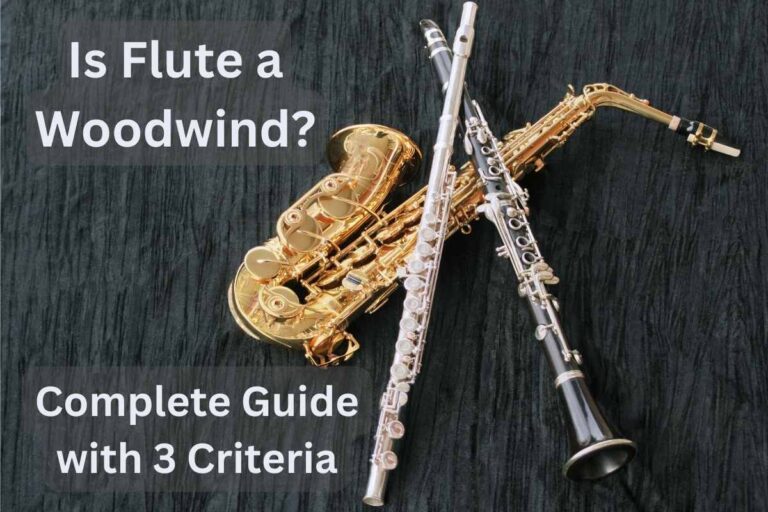Best Flute Articulation Exercises — 5 FREE Proven Sheet Music PDF

Ever felt like your tonguing was a bit off? No worries! Flute articulation exercises make your notes pop and shine. I’ve got five awesome exercises that’ll fix that right up.
These aren’t just any old exercises. They work wonders for all flute players, from beginners to PROs. And guess what? They’re totally free!!
My five flute articulation exercises cover the big stuff — legato, staccato, accents, scales, and arpeggios. If your staccato sounds sloppy or legato feels like a blob — you’re not alone!! Flutists at every level run into this.
You’ll get a PDF for each exercise — all five PDFs are printable! Just spend 10-15 minutes a day on these exercises. You’ll be amazed at how quickly you improve. Let’s make some beautiful music together, flute friends!

What Is Flute Articulation
Think of flute articulation as punctuation in a sentence. Articulation adds meaning, clarity, and style. It controls how each note starts, ends, and connects.
When you play a note, your tongue controls the start. Most players use a soft “tuh” sound.
There are different kinds of articulation. Each type creates a different mood, texture, or energy. Some are smooth and connected. Others are short and snappy.
| Articulation Type | How It Sounds | How to Play It |
|---|---|---|
| Legato | Smooth, connected | Soft tonguing, or none at all |
| Staccato | Short, detached | Quick “tuh” and lift the air fast |
| Marcato | Strong, accented (like a punch) | Firm attack with more tongue force |
| Tenuto | Held notes, slightly emphasized | Gentle start, keep airflow steady |
| Slurred | Notes flow with no tongue between | Only tongue the first note |
Another big key is tonguing. You’ve got three main ones:
- First, there’s single tonguing — say “tuh tuh tuh” over and over.
- Then comes double tonguing — “tuh kuh tuh kuh”.
- And the fastest is triple tonguing — “tuh tuh kuh” or “tuh kuh tuh”.
Now — why does this matter? Easy. It makes your tone, rhythm, and phrasing way better. You get clean attacks. You can control the start and end of every note. You shape phrases how you want them to sound.
Without flute articulation, everything blends into a mess.
So yeah, articulation isn’t extra—it’s essential. It’s how you go from just playing notes to actually making music. Once it clicks, you’ll wonder how you ever played without it.
For more flute exercises, check “Flute Long Tones: Download 3 Proven Exercises PDF“
Flute Articulation 1 — Basic Flute Articulation Exercise
The “Flute Articulation” exercise helps train control and precision — especially for clean tonguing and smooth transitions!! It’s one of those exercises that looks simple but REALLY boosts your technique.
- Key: C Major
- Time: 4/4
- Dynamics: mf > mp, mp < mf
- Length: 24 measures
It goes from light patterns to note groups: 4, 12, and 16 notes! It’s bright, structured, and honestly kind of fun. Every line is getting more challenging…
…At least, that’s how it feels when you’re playing. The patterns shift between tongued and slurred notes. They test how well your fingers and tongue stay synced. The rhythms are mostly eighth and sixteenth notes.
There’s a lot of dynamic change too — like “mp” and “mf” — which makes this a breath control workout too.
Watch for staccato marks (dots above the notes). Those mean “tongue lightly, then release.” Then, when you see slurs (the curved lines), play those notes connected — no tongue between them.
Flute Articulation 2 — Legato Flute Exercise
The “Flute Legato Exercise” teaches you how to play with a smooth, flowing sound.
The word “legato” just means all the notes are connected. You won’t find any harsh breaks or sharp attacks here — only clean transitions and steady breath.
- Key: Major scales
- Time: 4/4
- Tempo: 72 bpm
- Length: 48 measures
It includes 12 phrases, and each one explores a different key. Each phrase has gentle note patterns — mostly scales with small steps. Each phrase ends on a long, held note — giving you time to rest, breathe, or reset.
When you begin this legato study, go slow. The goal here isn’t speed— it’s smoothness!! Use slow, even air to carry the sound.
If one key gives you trouble, pause and work on that part alone. Don’t push too fast through all 12. Break it into 2–3 phrases per day.
Flute Articulation 3 — Flute Staccato Exercise
The “Flute Staccato Exercise” teaches how to play short, detached notes cleanly using tongue control. This practice helps with quick passages, dotted rhythms, and dance-like phrases.
- Key: G Major
- Time: 4/4
- Combines “HA” and “TA” tonguing
- Range: Works across low and mid-range
- Length: 24 measures
The rhythms are made of eighth notes, sixteenth notes, and a final fermata. There are no rests in the first half — it’s a steady stream of staccato notes. Notes move stepwise up and down the scale.
Each group of notes uses clear staccato markings:
- Bars 1 to 8 warm up the tongue with repeated scale motions.
- Bars 9 to 16 start mixing the rhythm.
- Bars 17 to 24 leap over intervals and change direction fast!
The idea is to keep everything bouncy, clear, short — without rushing or dragging.
Flute Articulation 4 & 5 — Flute Major Scales & Arpeggios
The “Flute Major Scales & Arpeggios Exercise” builds solid playing habits. It includes all twelve major scales + matching arpeggios! It’s also a great way to warm up your fingers and prepare your brain.
- Key: Major scales
- Moves through the circle of fifths
- Time: 4/4
- Length: 143 measures
This exercise follows the circle of fifths — each new key adds just one sharp or flat. That helps your brain remember which keys come next.
Start slow — DON’T rush it!! Play the full scale going up and down.
Add the arpeggio right after the scale. It follows a simple pattern — root, third, fifth, and octave — the “chord ladder”. The first, third, and fifth notes build a triad. When you play them one at a time, it becomes an arpeggio.
Make sure to take little breaks between keys. Give your brain and breath a second to reset.
I have more scales in my “5 Flute Scales: Free Major, Minor, & Chromatic Scales PDFs” post
How to Work Through the Exercises
Start really slow — like “talking speed” — and pay close attention to how your tongue touches each note. Don’t worry if it feels awkward at first. Stay relaxed and focused.
You notice your tongue gets tired fast, especially with staccato. That’s NORMAL!! Try switching to a softer tonguing syllable — “du” instead of “tu”. Try different syllables when you practice. Use “tu,” “du,” “ku,” or “ta” to develop flexibility. Also, take breaks and don’t burn out your embouchure.
If your fingers get tangled during the fast parts, go even slower. Try practicing without sound first — just finger the notes silently. And check “Flute Alternate Fingerings: A Complete Guide for Beginners.“
And don’t try to play it all at once. I recommend breaking it into short sections. Master each section before moving on.
Remember, you’re not just playing notes — you’re training habits your whole flute playing depends!! Switch up your articulation. Tongue one day, slur the next. Mix them mid-exercise if you’re feeling bold.
Don’t forget to rest and breathe. You’re not just training fingers — you’re building endurance. For more details, read my “Flute Embouchure: 7 Top Tips to Develop A Strong Technique“!
Use a metronome. It keeps you honest about your speed. Record your practice every so often. Listen for tone, smoothness, and mistakes.
Conclusion: Proven 5 Flute Articulation Exercises
My five free flute articulation exercises PDFs cover all the basics you need.
Remember that good articulation starts with your tongue position. Keep it light and quick — think “tu” or “du” sounds, not heavy “tuh” sounds that’ll slow ya down.
Download all five PDF exercises today and add them to your daily practice routine!!
Look into “13 Best Flute Brands – Ranked And Reviewed“!






